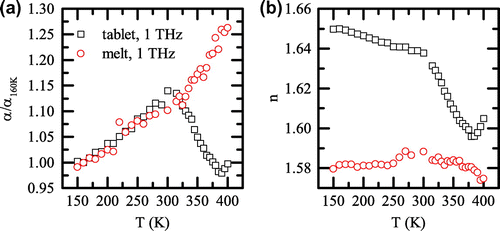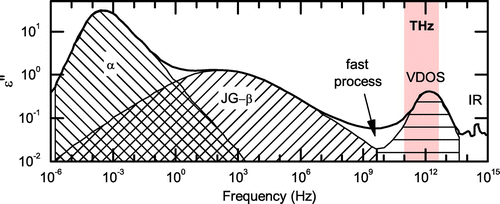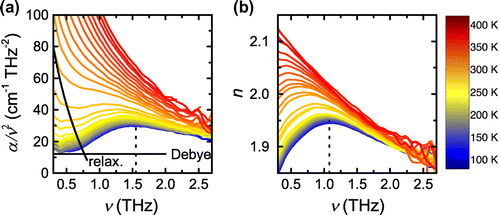Figures & data
Figure 1. (colour online) (a) Copper sample holder. The windows are pressed together by a copper cradle, with PTFE rings between the quartz and copper to allow differential thermal expansion. The sample is held in the mylar spacer between the windows, with an optional slit cut in it to avoid bubble formation in the centre of the sample. This cradle is then bolted to the coldfinger of the cryostat. After [Citation9]. (b) Corresponding schematic of the reference (top) and sample (bottom) layer structure. Adapted from [Citation10].
![Figure 1. (colour online) (a) Copper sample holder. The windows are pressed together by a copper cradle, with PTFE rings between the quartz and copper to allow differential thermal expansion. The sample is held in the mylar spacer between the windows, with an optional slit cut in it to avoid bubble formation in the centre of the sample. This cradle is then bolted to the coldfinger of the cryostat. After [Citation9]. (b) Corresponding schematic of the reference (top) and sample (bottom) layer structure. Adapted from [Citation10].](/cms/asset/46fa8b07-d441-416e-b387-8690e5144be6/tphm_a_1111528_f0001_oc.gif)
Figure 2. (colour online) (a) Absorption coefficient and (b) refractive index of polyvinylpyrrolidone/vinyl acetate (Kollidon VA 64) at 1 THz prepared as tablet (black squares) and thin film from melt (red circles).

Figure 3. (colour online) Comparison between dielectric and terahertz spectroscopy results of amorphous sorbitol. Data represent dielectric spectroscopy measurement [Citation14]. Solid lines are terahertz data extracted by the method of Duvillaret et al. [Citation10] and considering the complex refractive index of windows and sample. Dashed lines are based on the explicit calculation of the terahertz optical properties using Beer–Lambert law, resulting in a positive absorption coefficient offset of few cm and consequent wing in the dielectric losses at low frequencies. Adapted from [Citation5].
![Figure 3. (colour online) Comparison between dielectric and terahertz spectroscopy results of amorphous sorbitol. Data represent dielectric spectroscopy measurement [Citation14]. Solid lines are terahertz data extracted by the method of Duvillaret et al. [Citation10] and considering the complex refractive index of windows and sample. Dashed lines are based on the explicit calculation of the terahertz optical properties using Beer–Lambert law, resulting in a positive absorption coefficient offset of few cm and consequent wing in the dielectric losses at low frequencies. Adapted from [Citation5].](/cms/asset/125a3f80-bb26-47c7-a1d8-16fd75498108/tphm_a_1111528_f0003_oc.gif)
Figure 4. (colour online) Schematics of different relaxations and vibrations in dielectric spectra of amorphous materials. Adapted from http://www.physik.uni-augsburg.de/lehrstuehle/exp5/themen/dismatter/glassfl/.

Figure 5. (colour online) Terahertz absorption of amorphous sorbitol, trehalose and BSA between 80 and 340 K at 0.8 THz. Adapted from [Citation19].
![Figure 5. (colour online) Terahertz absorption of amorphous sorbitol, trehalose and BSA between 80 and 340 K at 0.8 THz. Adapted from [Citation19].](/cms/asset/6e7d1ab1-5da5-43e4-947e-0395ce0d47b2/tphm_a_1111528_f0005_oc.gif)
Figure 6. (colour online) Dielectric losses of amorphous sorbitol observed by a combination of terahertz spectroscopy and Diamond Light Source [Citation22]. Inset shows a detail of the spectra between 4.4 and 4.8 THz.
![Figure 6. (colour online) Dielectric losses of amorphous sorbitol observed by a combination of terahertz spectroscopy and Diamond Light Source [Citation22]. Inset shows a detail of the spectra between 4.4 and 4.8 THz.](/cms/asset/cfd469bf-068d-444b-8ea7-5b4e213a0876/tphm_a_1111528_f0006_oc.gif)
Figure 7. (colour online) Terahertz spectra of amorphous sorbitol between 80 and 420 K: (a) Rescaled absorption coefficient and (b) refractive index. The solid lines are plotted to guide the eye and highlight the Debye and relaxational contribution to the rescaled absorption coefficient. The dashed lines highlight the frequency of the peak maximum which is observed at 1.55 THz in (a) and 1.08 THz in (b).

Figure 8. Temperature dependence of the frequency shift of the longitudinal acoustic modes as obtained by Brillouin scattering. The data are taken form [Citation26]. The solid lines represent linear fits. The dashed lines highlight K and
K.
![Figure 8. Temperature dependence of the frequency shift of the longitudinal acoustic modes as obtained by Brillouin scattering. The data are taken form [Citation26]. The solid lines represent linear fits. The dashed lines highlight K and K.](/cms/asset/4242c50d-cd28-40b2-a4ed-fdde4116efb8/tphm_a_1111528_f0008_b.gif)
